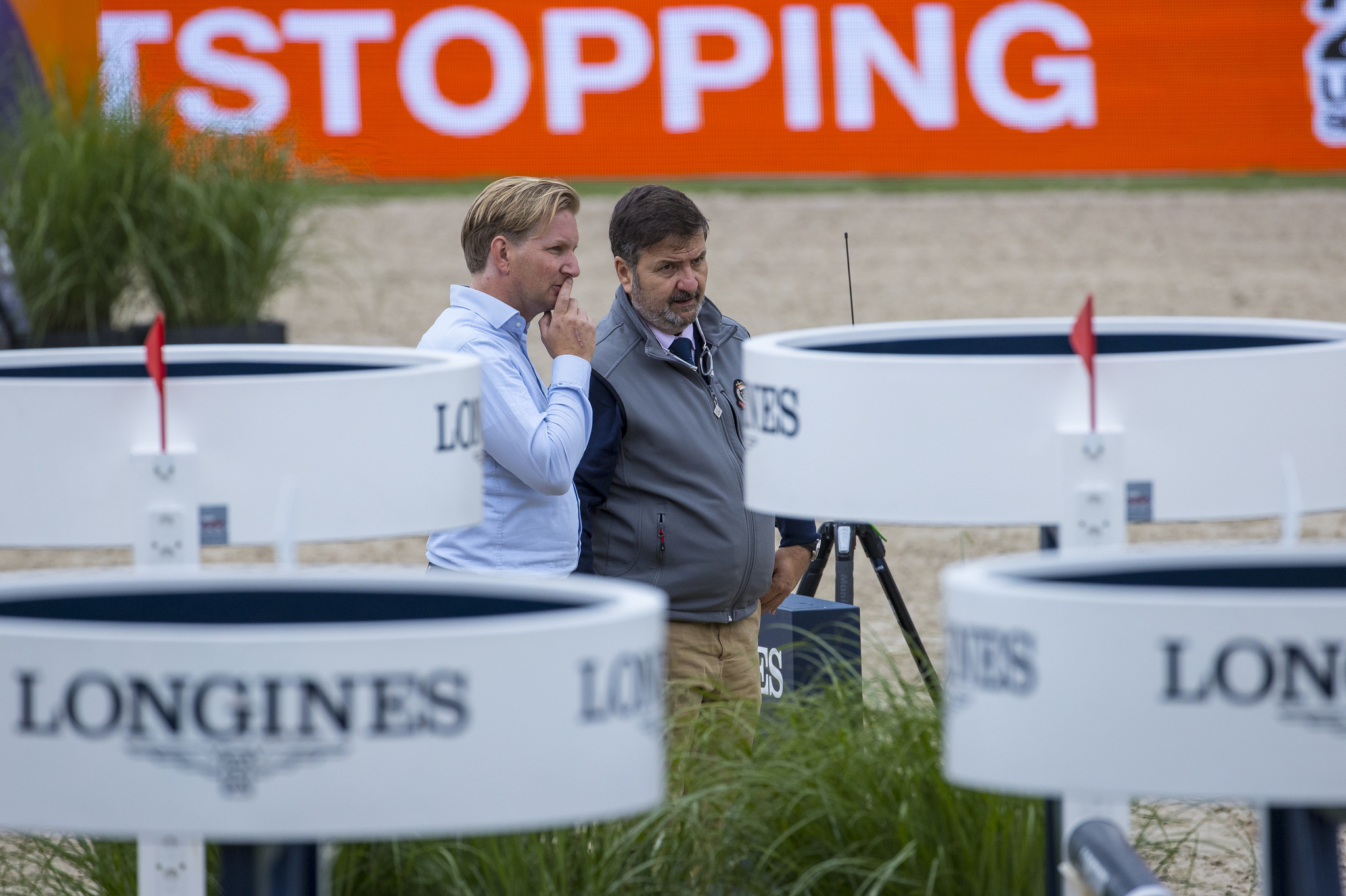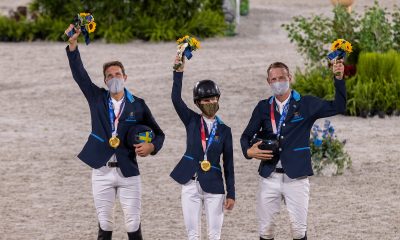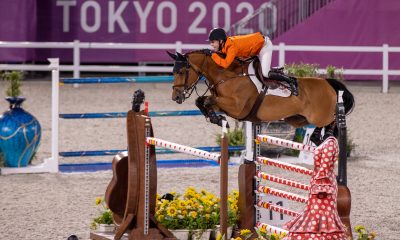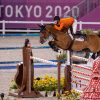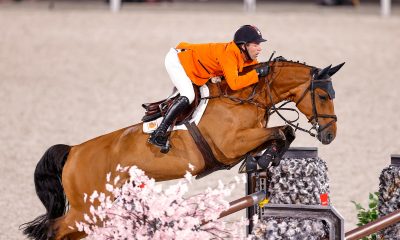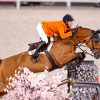Quintin Maertens in Tokio: “Parcoursbouwen is als een goed verhaal” – 🇬🇧
Please scroll down below to find the English translation of this article
Volgens Quintin Maertens is paardrijden geen sport maar een kunst. “Van harmonie geniet zowel het paard als de ruiter, ik gun iedereen het gevoel van harmonie. Dat maakt de paardensport zo fantastisch.” Een mooie visie van een van Nederlands beste parcoursbouwers.
Hij denkt over alles na, is kritisch, creatief, heeft gevoel voor humor en immense passie voor het paard. Afgelopen week reisde de goedlachse Quintin Maertens af naar de Olympische Spelen. “Parcoursbouwen is als een goed verhaal, je wilt niet dat het voorspelbaar is waar de fouten worden gemaakt en je wilt mensen tot aan het eind toe boeien. Gebeurt dat niet dan kun je beter friet gaan halen en terugkomen voor de barrage”, merkt Quintin lachend op.
Extra dimensie
De Olympische Spelen zijn niet zijn eerste grote kampioenschap, eerder stond hij Louis Konickx al bij tijdens het EK in Gotenburg en Rotterdam. “Kampioenschappen zijn geweldig om te bouwen, niet alleen omdat het het hoogste niveau is maar ook omdat je met de mooiste hindernissen mag werken. Dat geeft weer een extra dimensie aan ons werk. Daarnaast is het technische aspect slechts een deel van wat wij doen. We hebben te maken met belangen van ruiters, sponsoren en organisaties. Het is onwijs leuk om met een team samen te werken, ik vind het vreselijk om alleen te werken.”
Geïnspireerd door paarden
Zijn familie komt niet ‘uit de paarden’, maar van kleins af aan wordt Quintin geïnspireerd door paarden. Hij begon net als zovelen op een manege en kreeg vervolgens zijn eerste pony. Zijn hobby groeide uit tot zijn eigen trainings- en handelsstal. “Omdat ik geen paardenachtergrond had, was ik qua kennis vooral aangewezen op mijzelf. Dat heeft als grote voordeel dat ik geen visie of systeem ingeprent heb gekregen, maar geheel mijn eigen weg kon gaan. Ik wil van alles heel graag weten hoe het zit, waarom wij dingen op een bepaalde manier doen. Dat is ook de reden dat ik de opleiding voor parcoursbouwer heb gevolgd. Ik miste kennis en wilde gewoon heel graag meer weten over het rijden van parcoursen.”
Uit de running
Inmiddels 18 jaar geleden, op 24-jarige leeftijd, startte Quintin aan de opleiding voor parcoursbouwer. Hij rondde deze succesvol af en combineerde zijn eigen stal met lesgeven en parcoursbouwen. Totdat hij van het paard viel en vier jaar lang uit de running was. “Door mijn ongeluk kreeg ik ineens veel tijd voor parcoursbouwen en lesgeven. Ik ben veel weggeweest en heb veel gereisd. Ik houd van het avontuur en nieuwe mensen leren kennen. Mijn stal was ik volop aan het verbouwen, dat heb ik afgemaakt maar ik heb er nooit echt gebruik van gemaakt doordat ik inmiddels zo veel op pad was. De dingen lopen nu eenmaal zoals ze lopen.” Het reizen heeft ook een keerzijde. Waar Quintin momenteel 15 – 20 weken per jaar parcoursen bouwt was dat voorheen het dubbele. “Reizen is leuk maar vraagt ook veel van je. Een leven in Nederland heb ik niet echt, dat is ook de reden dat ik nu meer in Nederland ben. En om creatief te blijven kan ik eigenlijk ook niet meer parcoursen bouwen dan dat ik nu doe.”
Kritisch kijken naar paardensport
“De paardensport kan geweldig mooi zijn, maar dat heeft alles te maken met hoe wij omgaan met onze paarden. Daar mogen we best kritisch naar kijken. Als een paard graag deelneemt aan dat wat wij van hem vragen is het fantastisch om daar een bijdrage aan te kunnen leveren. Wij als parcoursbouwer kunnen daarin sturen met onze parcoursen. Een paard is van nature een vluchtdier en wil graag naar voren. Kijk maar naar een veulentje, die wil ook graag rennen in de wei. Wanneer wij parcoursen bouwen waarin vraagstukken naar voren toe opgelost moeten worden, dan gaan ruiters dat, als het goed is, thuis trainen. Die minuut in het parcours gaat niet het verschil maken hoe een paard zich voelt, maar de training tijdens de rest van de week wel. We gaan gelukkig steeds meer weg van het dominant rijden en er wordt steeds meer naar voren toe gereden. Wij moeten als parcoursbouwers vragen stellen in het parcours die combinaties kunnen beantwoorden. Daarnaast zijn paarden steeds beter ‘gemaakt’ voor hun werk. Het is steeds minder een vraagstuk of paarden het werk willen doen, zij zijn ervoor gemaakt. Paarden die niet willen, redden de parcoursen van tegenwoordig niet meer. Vergelijk het met een Sint-Bernardshond die een kudde schapen bijeen moet drijven of een Bordercollie. Die laatste is ervoor gemaakt en weet wat hem te doen staat. Dat is met de springpaardenfokkerij net zo.”
“Ik doe niks zonder reden”
Niet alleen over de paardensport denkt Quintin kritisch na, ook bij zijn werk als parcoursbouwer past hij dit toe. “Ik doe niks zonder reden, een stijl van 1.58m staat er omdat het een stijl is en niet omdat het een oxer van 1.53m had moeten zijn. Ik wil ook niet voor de hand liggende lijnen gebruiken, als een ander het kan bedenken hoef ik het niet meer te doen”, voegt hij lachend toe. “Natuurlijk valt soms iets niet helemaal uit zoals gepland maar mijn streven is altijd een vloeiend parcours dat paardvriendelijk is. Mijn ideale parcours is het parcours waarin het paard met het meeste succes, ook het paard is dat zich het prettigst voelde. Je wilt een parcours maken dat mensen onthouden, als een parcours te mooi is, gebeurt dat niet. Vergelijk het maar met muziek, voorspelbare muziek is leuk voor op de achtergrond maar goede muziek blijft je boeien. Dat is met parcoursbouwen ook.” Om nog maar eens een metafoor te gebruiken.
Emotie
Je legt de lat voor jezelf hoog, ben je wel eens ooit tevreden? Lachend: “Jazeker, je krijgt als parcoursbouwer veel emotie terug van een enthousiast publiek dat op de banken gaat staan. Die emotie voelen en dat mensen elkaar vertellen dat het een mooie wedstrijd was, daar doen we het voor. Iedereen die bijvoorbeeld aanwezig was bij het EK in Gotenburg kan zich de rit van Peder Fredricson nog goed herinneren. Hij mocht 6 fouten maken om goud te winnen, zijn hele parcours verliep goed en op de laatste lijn kreeg hij een balk en een tijdfout. Die spanning is precies wat wij willen.”
Nooit gedacht
En nu op naar de Spelen, kijk je er naar uit? “Iedereen met een sportershart vindt de Olympische Spelen iets bijzonders. Ik heb nooit gedacht dat ik daarnaartoe zou gaan en al helemaal niet als parcoursbouwer.” Tijdens het CHIO Rotterdam heb je een generale repetitie gehad, aangezien Santiago Varela daar ook mocht bouwen. “Ik heb tijdens het CHIO met hem gewerkt en ken het team goed. Dat maakt het minder spannend. Santiago neemt bewust jonge mensen mee om hun de kans te geven. Het voelt heel goed, je weet wat je aan de mensen hebt. Verder hoop ik vooral dat het een echte Olympische Spelen wordt, de sfeer gaat sowieso anders zijn door de vele restricties. Daarnaast heeft het springen een nieuwe formule, je kunt nu minder goed het kaf van het koren scheiden op de eerste dag, daar moeten we voor de volgende Olympische Spelen lessen uit trekken.”
Bron: DigiShots News
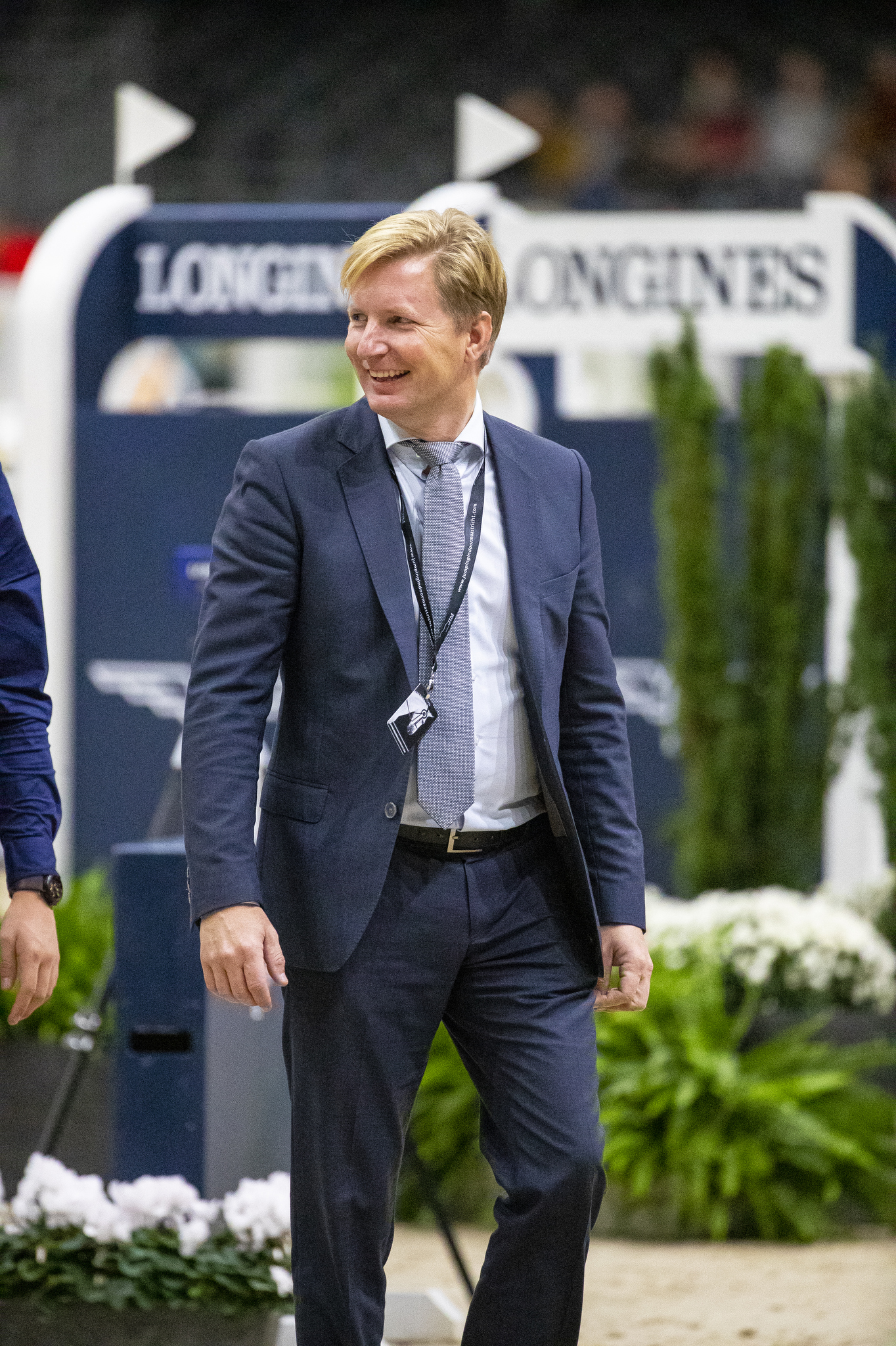
English translation
According to Quintin Maertens, horse riding is not a sport but an art. “Both horse and rider enjoy harmony, I wish everyone that feeling of harmony. That is what makes equestrian sport so fantastic.” A beautiful vision from one of the best Dutch course designers.
He thinks about everything, is critical, creative, has a sense of humor and immense passion for the horse. Last week the cheerful Quintin Maertens travelled to the Tokyo Olympic Games. “Course building is like a good story, you don’t want it to be too predictable where the mistakes will be made and you want to keep people interested right through to the end. If that doesn’t happen, it’s better to just go get fries and come back for the jump-off”, Quintin remarks with a laugh.
Extra dimension
The Olympic Games are not his first major championship: he previously assisted Louis Konickx during the European Championships in Gothenburg and Rotterdam. “Championships are great to build, not only because it’s the highest level, but also because you get to work with the most beautiful obstacles. That gives an extra dimension to our work. In addition, the technical aspect is only a small part of what we do. We are dealing with the interests of riders, sponsors and organizations. It is great fun to work with a team, I hate working alone.”
Inspired by horses
His family does not come from horses, but Quintin has been inspired by horses from an early age. Like so many others, he started out at an riding school and then got his first pony. His hobby grew into his own training and trading stable. “Because I didn’t have a equine background, I was mainly dependent on myself in terms of knowledge. This has the great advantage that I was not imprinted with a vision or system, but that I could go and do things my own way. I really want to know about everything, figure out why we do things a certain way. That is also the reason that I followed the course designer course. I lacked knowledge and just really wanted to know more about riding courses.”
Out of the running
Eighteen years ago, at the age of 24, Quintin started his training to become a course designer. He successfully completed his studies and combined his own stable with instructing and course building. That was unntil he fell off the horse and was out of the running for four years. “Due to my accident, I suddenly had a lot of spare time for course building and teaching. I’ve been away a lot and I’ve traveled a lot. I like the adventure and meeting new people. I was busy renovating my stable, I actually finished that but eventually I never really used it because I was on the road so much. Things just work out the way they do.” Traveling also has a downside. Where Quintin currently builds courses for 15 to 20 weeks a year, this used to be double that. “Travel is fun, but it also demands a lot from you. I didn’t really have a social life anymore in The Netherlands, which is also the reason that I am in The Netherlands much more now. And to remain creative, I honestly can’t really build more courses than I’m doing now.”
Looking critically at equestrian sports
“Equestrian sport can be very beautiful, but that has everything to do with how we treat our horses. We should take a critical look at that. If a horse likes to participate in what we ask of him, it is fantastic to be able to contribute to that. As a course builder, we can manage this with our courses. A horse is a natural flight animal and wants to move forward. Just look at a foal, he also likes to run in the meadow. When we build courses in which issues have to be solved forwards, riders will, if all goes well, train at home. That minute in the course won’t make all the difference in how a horse feels, but the training during the rest of the week will. Fortunately, we are moving away from that dominant style of riding: more and more riders are focussing on riding forward. As course designers we have to ask questions in the course that the combinations are able to answer to. In addition, horses are increasingly ‘made’ for their work. It is less and less a question of whether horses want to do the work, they are made for it. Horses that don’t want to, won’t be able to complete today’s courses. Compare it to a Saint Bernard who has to round up a flock of sheep or a Border Collie. The latter is made for it and knows what to do. The same is true with the breeding of show jumpers.”
“I don’t do anything without a reason”
Quintin does not only think critically about equestrian sports, he also applies this view to his work as a course designer. “I don’t do anything for no reason, a 1,58m vertical is there because it’s a vertical and not because it should have been a 1,53m oxer. I also don’t want to use obvious lines, if someone else can think of it, I don’t have to do it anymore,” he adds with a laugh. “Of course, sometimes things don’t go quite as planned, but my goal is always a flowing course that is horse friendly. My ideal course is a course in which the horse with the most success is also the horse that felt the most comfortable to ride. You want to create a course that people remember. If a course is too beautiful, it won’t happen. Compare it to music, predictable music is nice in the background, but good music keeps you fascinated. That is also the case with course building”, says Quintin wisely, using another metaphor.
Emotion
You set the bar high for yourself, are you ever satisfied? Laughing: “Yes, as a course designer you get a lot of emotion back from an enthusiastic audience that stands on their seats. Feeling that emotion and that people tell each other that it was a great competition, that’s what we do it for. For example, anyone who attended the European Championships in Gothenburg can still remember Peder Fredricson’s ride. He was allowed to make six mistakes to win gold, his entire course went well and on the last line he got a bar and a time fault. That tension is exactly what we want.”
Never thought
And now on to the Games, are you looking forward to it? “Anyone with an athlete’s heart thinks the Olympics is something special. I never thought I would go there, especially not as a course designer.” During the CHIO Rotterdam you had a bit of a dress rehearsal, as Santiago Varela was also allowed to build there. “I worked with him during CHIO and know the team well. That certainly makes it a bit less nervewrecking. Santiago consciously takes young people along to give them the opportunity to develop. It feels very good, you know what you can do with people. Furthermore, I truly hope that it will become a proper, real Olympic Games. The atmosphere will certainly be different due to the many restrictions. In addition, jumping has a new formula, which makes it a lot less easy to separate the wheat from the chaff on the first day. We see how that goes and should make sure we learn our lessons from that for the next Olympic Games.”
Source: DigiShots News


